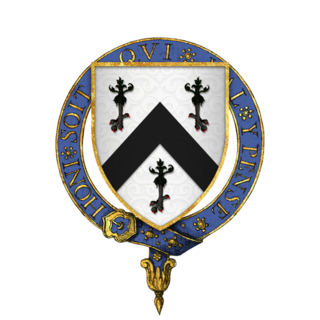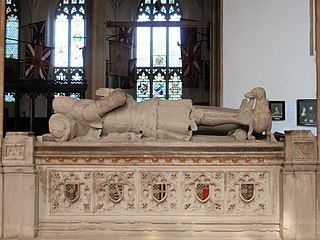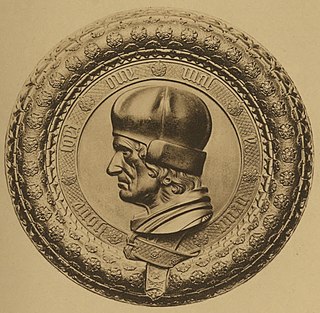Related Research Articles

Henry VII was King of England and Lord of Ireland from his seizure of the crown on 22 August 1485 until his death in 1509. He was the first monarch of the House of Tudor.

The House of Tudor was a royal house of Welsh-French origin that held the English throne, descended from the Tudors of Penmynydd and Catherine of France. Tudor monarchs ruled the Kingdom of England and its realms, including their ancestral Wales and the Lordship of Ireland from 1485 until 1603, with five monarchs in that period: Henry VII, Henry VIII, Edward VI, Mary I and Elizabeth I. There is also a sixth Tudor monarch, Jane Grey, who reigned for nine days, in between Edward VI and Mary I. The Tudors succeeded the House of Plantagenet as rulers of the Kingdom of England, and were succeeded by the House of Stuart. The first Tudor monarch, Henry VII of England, descended through his mother from a legitimised branch of the English royal House of Lancaster, a cadet house of the Plantagenets. The Tudor family rose to power in the wake of the Wars of the Roses (1455–1487), which left the Tudor-aligned House of Lancaster extinct in the male line.

Elizabeth of York was Queen of England from her marriage to King Henry VII on 18 January 1486 until her death in 1503. Elizabeth married Henry after his victory at the Battle of Bosworth Field, which marked the end of the Wars of the Roses. Together, they had seven children.

The Croyland Chronicle, also called Crowland Chronicle, is an important primary source for English medieval history, particularly the late 15th century. It is named for its place of origin, the Benedictine Abbey of Croyland or Crowland, in Lincolnshire, England. It was formerly also known as the Chronicle of Ingulf or Ingulphus after its supposed original compiler, the 11th-century abbot Ingulf. As that section of the text is now known to have been a later forgery, its author is instead known as Pseudo-Ingulf. The validity of the source itself has been questioned, partially due to the unknown identity of the original author, and gaps in all continuations of the text. There has also been substantially little effort made to find and translate the original manuscript.

Sir Reginald Bray was an English administrator and statesman. He was the Chancellor of the Duchy and County Palatine of Lancaster under Henry VII, briefly Treasurer of the Exchequer, and one of the most influential men in Henry VII's government and administration. He was an estate officer and senior councillor to both Henry VII and the king's mother, Margaret Beaufort. He was a major benefactor to St George's Chapel, Windsor, where some of the building work for which he provided funds can still be seen and identified.

The Tudor rose is the traditional floral heraldic emblem of England and takes its name and origins from the House of Tudor, which united the House of Lancaster and the House of York. The Tudor rose consists of five white inner petals, representing the House of York, and five red outer petals to represent the House of Lancaster.

Sir Robert Drury (1456–1536) was an English knight, Lord of the Manor of Hawstead, Suffolk, and Knight of the Body to Kings Henry VII and Henry VIII. As a politician he was Knight of the Shire for Suffolk, Speaker of the House of Commons, and Privy Councillor. He was also a barrister-at-law. His London townhouse was on the site of today's Drury Lane.
Sir James OrmondaliasButler was the son of John Butler, 6th Earl of Ormond. He was Lord Treasurer of Ireland from 1492 to 1494, and helped to defend the Lordship of Ireland against the forces of Perkin Warbeck. He was murdered by Sir Piers Butler on 17 July 1497. Piers would later hold the title of Earl of Ormond.

Thomas Savage was a prelate, diplomat and scholar during the Tudor period. Savage served as Chaplain to King Henry VII and was Archbishop of York from 1501 until his death in 1507. Prior to his consecration as a Bishop, Savage served as a diplomat and rector. As a diplomat Savage held the positions of English Ambassador to Castile and Portugal, during which time he helped broker the marriage treaty between Arthur, Prince of Wales and Catherine of Aragon in 1489, and later held the position of English Ambassador to France from 1490, where he took part in the conference at Boulogne.
The Intercursus Magnus was a major and long-lasting commercial treaty signed in February 1496 by King Henry VII of England and Duke Philip IV of Burgundy. Other signatories included the commercial powers of Venice, Florence, the Netherlands, and the Hanseatic League.

The Stafford and Lovell rebellion was the first armed uprising against King Henry VII after he won the crown at the Battle of Bosworth in 1485. The uprising was led by Francis Lovell, Viscount Lovell along with Sir Humphrey Stafford and Thomas Stafford, brothers from Grafton, Worcestershire. The uprising occurred during Eastertime 1486.

Sir Thomas Lovell, KG was an English soldier and administrator, Speaker of the House of Commons, Secretary to the Treasury and Chancellor of the Exchequer.
Sir William Norreys was a famous Lancastrian soldier, and later an Esquire of the Body to King Edward IV.
Events from the 1480s in England. This decade marks the beginning of the Tudor period.
Events from the 1490s in England.

Giles Daubeney, 1st Baron Daubeney, KG PC was an English soldier, diplomat, courtier and politician.
Philibert de Chandée, 1st Earl of Bath was an Earl in the English peerage.

Sir Richard Pole, KG was a Welsh-born supporter and first cousin of King Henry VII of England. He was created a Knight of the Garter and was married to Margaret Plantagenet, Countess of Salisbury, a member of the Plantagenet dynasty: a marriage which reinforced the Tudor alliance between the houses of Lancaster and York.

Philippe de Crèvecœur, seigneur d'Esquerdes (1418–1494), was a French military commander and a Marshal of France in 1486. He is also known as Maréchal des Cordes or Maréchal d'Esquerdes.

Sir Henry Vernon, KB, was a Tudor-era English landowner, politician, and courtier. He was the Controller of the household of Arthur, Prince of Wales, eldest son of Henry VII of England and heir to the throne until his untimely death.
References
- ↑ spelling - Baker's own Will, National Archives
- ↑ Thornton, Tim (2012). The Channel Islands, 1370–1640: between England and Normandy. The Boydell Press. pp. 60–62. ISBN 9781843837114.